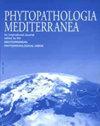Activity of bacterial seed endophytes of landrace durum wheat for control of Fusarium foot rot
IF 1.9
3区 农林科学
Q2 AGRONOMY
引用次数: 2
Abstract
Five bacterial endophytic isolates obtained from durum wheat seeds (landrace “Timilia reste nere”) and identified as belonging to Pantoea (isolates A1, F7, F15 and G1) and Paenibacillus (isolate B) genera on the basis of 16S rDNA gene sequences, were assayed in vitro and in vivo for their ability to inhibit Fusarium culmorum growth and the disease (Fusarium foot rot) it causes in durum wheat. All isolates significantly reduced in vitro growth of F. culmorum in comparison with the control. After 120 hours of incubation, isolates B and G1 showed the greatest mycelial growth inhibition, i.e., respectively, 76 and 74%. When durum wheat “Simeto” seeds were treated with bacterial isolates singly or in combinations and then inoculated with F. culmorum, all treatments with endophytes showed increased, but not statistically significant, seed germination. Except for isolate A1, all bacterial isolates stimulated vegetative parameters of durum wheat seedlings. Mixture of isolates F7 + F15 was the most effective in improving shoot height (+94%), root length (+47%) and vigour index (+81%). Mixture of isolates A1 + B reduced Fusarium foot rot incidence (-21%) and severity (-30%), and isolate A1 reduced incidence (-15%) and severity (-16%) of the disease. These results indicate potential of bacterial seed endophytes, identified in this study, for control of Fusarium foot rot and suggest that bacterial seed endophytes may provide a new biocontrol agent for an environmentally sustainable durum wheat disease management programme.地方硬粒小麦细菌种子内生菌活性对赤霉病的防治作用
从硬粒小麦种子(地方品种“Timilia reste nere”)中分离出5株内生细菌,根据16S rDNA基因序列鉴定为Pantoea (A1, F7, F15和G1)和Paenibacillus (B)属,对它们在体外和体内抑制硬粒小麦镰刀菌(Fusarium culmorum)生长及其引起的枯萎病(Fusarium foot rot)的能力进行了研究。与对照相比,所有分离株的体外生长均显著降低了镰刀菌的生长。孵育120 h后,分离株B和G1对菌丝生长的抑制作用最大,分别为76%和74%。将硬粒小麦“Simeto”种子单独或组合处理,然后接种F. culmorum,所有内生菌处理都增加了种子的萌发,但没有统计学意义。除菌株A1外,其余菌株均能刺激硬粒小麦幼苗的营养参数。分离株F7 + F15在提高株高(+94%)、根长(+47%)和活力指数(+81%)方面效果最好。分离物A1 + B的混合物降低了赤霉病的发病率(-21%)和严重程度(-30%),分离物A1降低了赤霉病的发病率(-15%)和严重程度(-16%)。这些结果表明,本研究发现的细菌种子内生菌具有控制赤霉病的潜力,并提示细菌种子内生菌可能为环境可持续的硬粒小麦病害管理计划提供一种新的生物防治剂。
本文章由计算机程序翻译,如有差异,请以英文原文为准。
求助全文
约1分钟内获得全文
求助全文
来源期刊

Phytopathologia Mediterranea
生物-植物科学
CiteScore
4.40
自引率
8.30%
发文量
28
审稿时长
6-12 weeks
期刊介绍:
Phytopathologia Mediterranea is an international journal edited by the Mediterranean Phytopathological Union. The journal’s mission is the promotion of plant health for Mediterranean crops, climate and regions, safe food production, and the transfer of new knowledge on plant diseases and their sustainable management.
The journal deals with all areas of plant pathology, including etiology, epidemiology, disease control, biochemical and physiological aspects, and utilization of molecular technologies. All types of plant pathogens are covered, including fungi, oomycetes, nematodes, protozoa, bacteria, phytoplasmas, viruses, and viroids. The journal also gives a special attention to research on mycotoxins, biological and integrated management of plant diseases, and the use of natural substances in disease and weed control. The journal focuses on pathology of Mediterranean crops grown throughout the world.
The Editorial Board of Phytopathologia Mediterranea has recently been reorganised, under two Editors-in-Chief and with an increased number of editors.
 求助内容:
求助内容: 应助结果提醒方式:
应助结果提醒方式:


